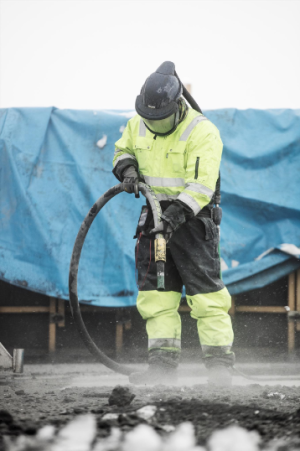What is silica and how do I get exposed?
Crystalline silica is a basic component of soil, sand, granite, and many other minerals. Quartz is the most common form of crystalline silica. Exposure occurs through inhalation of respirable particles created when silica-containing materials are manipulated. Activities such as chipping, cutting, cutting, drilling, blasting, and grinding of silica-containing materials are expected to produce respirable particles.
What are the primary sources of silica dust exposure?
Silica dust exposure is commonly seen in industries that perform sandblasting, jackhammering, foundry work, glass manufacturing, concrete cutting, and other abrasive work.

What are the hazards of silica exposure?
Inhaling silica particles can lead to several pneumoconiosis (scarring of the lungs from inhaled dust), with silicosis posing the most significant risk. Silicosis, a potentially fatal lung disease caused by inhaling crystalline silica particles, has no current cure and limited treatment options. Additionally, it heightens the risk of tuberculosis and lung cancer, influenced by factors such as age and exposure history. Prioritizing safety precautions to prevent inhalation of these particles is very important.
What exposures are allowable for silica?
In 2016, the Occupational Safety and Health Administration (OSHA) revised the permissible exposure limit (PEL) of respirable silica to 50 micrograms per cubic meter. This represents the maximum allowable concentration of respirable silica during an eight-hour work shift. A helpful guideline is that if airborne dust containing silica is visible, it likely exceeds the PEL. To address any concerns about potentially hazardous silica levels in your work environment, contact Environmental Health and Safety to discuss a hazard assessment.
What can I do to lower possible exposures?
Controlling silica dust can involve various solutions such as using wet methods, operating HEPA vacuums, and utilizing local exhaust ventilation systems. Respiratory protection can also be utilized to lower exposures, but should only be used in conjunction with engineering controls, or other control methods are not feasible. Additional personal protective equipment (PPE) such as disposable clothing, leather gloves, and safety glasses/goggles with face shields should be used. For areas affected by silica-containing materials:
Prioritize hand washing and consider showering before leaving work.
Remove and appropriately dispose of or launder PPE after each use.
Ensure contaminated PPE stays within designated work areas.
What should I do if I have additional exposure concerns?
If you still have concerns about past or future silica exposures, consult with Occupational Health and Wellness to see if participation in a medical surveillance program is necessary. You may also reference the Ohio State University Silica Dust Safety Program for additional information.
Be safe today and remain a Buckeye tomorrow.